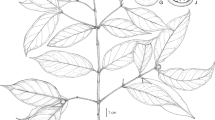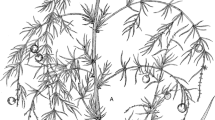Summary
A new species, Canscora shrirangiana Kambale, Kolte & A. Deshp. is described and illustrated here. The new species is morphologically similar to C. pauciflora.
Similar content being viewed by others
Avoid common mistakes on your manuscript.
Introduction
The genus Canscora Lam. is represented by nine species worldwide (Mabberley 2008) distributed in tropical Asia, Africa and Australia. In India it is represented by eight species (Shahina & Nampy 2014), and to date 44 binomials have been published in Canscora of which 11 are accepted (The Plant List 2013). Clarke (1885) treated 12 species of Canscora under three subgenera: Canscora subgen. Eucanscora C. B. Clarke, Canscora subgen. Heterocanscora Griseb., and Canscora subgen. Phyllocyclus C. B. Clarke from India. Shahina & Nampy (2014) revised this genus for south India and treated six species: C. alata (Roth) Wall., C. diffusa (Vahl) R. Br. ex Roem. & Schult., C. heteroclita (L.) Gilg, C. pauciflora Dalzell, C. perfoliata Lam. and C. roxburghii Arn. ex Miq. Rao (1986) reported four species of Canscora from Goa.
During floristic surveys along the lateritic plateaus of Goa, the authors collected some interesting specimens of Canscora. After perusing the relevant literature (Clarke 1885; Shahina & Nampy 2014) and consulting the types of all the species reported from India, it became apparent that they represent an undescribed species, which is described and illustrated below.
Materials and Methods
The plant specimens were collected and processed for the herbarium following the technique of Jain & Rao (1977) and flowers were preserved in 70% alcohol. GPS (Garmin 72H) coordinates of the type localities were recorded. Images of the flowers and their parts were taken using a Canon 700D. Microphotographs were taken using stereomicroscope (Leica WILD M3Z). Type specimens from CAL were examined and online type specimens available on the websites of BM, C, K, and P were also consulted.
Taxonomic Treatment
Canscora shrirangiana Kambale, Kolte & A.Deshp. sp. nov. Type: India, Goa, North Goa Distr., Mopa, 171 m alt., 29 Nov. 2015, S. S. Kambale & R. R. Kolte 352 (holotype CAL!; isotypes BSI!, K!, SUK! Goa University Herbarium!).
http://www.ipni.org/urn:lsid:ipni.org:names:77178772-1
Erect, annual, glabrous herb. Stem quadrangular, green when young, turns brown at maturity, 15 – 35 cm tall. Leaves simple, opposite, decussate, sessile; lamina 1 × 0.5 cm, linear to lanceolate, 3-veined, glabrous, margin entire. Inflorescence an axillary and terminal lax cyme, 1 – 3 flowered. Pedicels bluntly quadrangular, 0.2 – 0.6 cm long, glabrous; bracts green, linear-lanceolate, 2 – 3 mm long, glabrous. Calyx green, orange at maturity, persistent, with 3 striations per lobe, hyaline in between the striations, tubular, tube 0.7 – 1 cm long; lobes c. 1 mm long; sepals 4, linear-lanceolate. Corolla pale pink, tubular, funnel shaped; tube 0.8 – 1.1 cm long; petals 4, upper two petals equal, obovate, 0.7 – 1.3 × 0.6 – 1.2 cm; lower two petals half connate to form a deep slit in which one large stamen is lodged, 1.0 – 1.2 × 0.6 – 1.1 cm. Stamens 4, anisomorphic (1 large, 3 small); upper stamens: filaments 0.2 – 0.4 cm long, anther 0.1 – 0.2 cm long, orange, ovate; lower stamens: filaments 0.2 – 0.3 cm long, anther c. 1 mm long, pale yellow. Ovary green, 3 mm long; style 5 – 9 mm long, pink; stigma bifid, papillose. Capsules brown, sub-cylindric, c. 3 mm long. Seeds many; testa brown, reticulate. Figs. 1 & 2.
recognition
Canscora shrirangiana resembles C. pauciflora in having lax cymes, pedicellate flowers and striated calyx but differs in having linear to lanceolate leaves, uniformly thick pedicel, obovate petals with white veins, filaments attached to the base of corolla lobes, and style 3 times longer than ovary (vs ovate to lanceolate leaves, pedicel thickened below the calyx, orbicular petals without white veins, filaments attached at the mouth of corolla tube, style as long as ovary or slightly longer than ovary as in C. pauciflora). See Table 1.
distribution
India, Goa. Canscora shrirangiana is so far known from only three localities.
specimens examined . india
Goa, Mopa, 171 m alt., 29 Nov. 2015, S. S. Kambale & R. R. Kolte 352 (holotype CAL; isotypes BSI, Goa University Herbarium, K, SUK); Taleigaon, Goa University Campus, 56 m alt., 30 Nov. 2015, A. S. Deshpande 322 (Goa University, Herbarium); Amona, 12 Dec. 2015, S. S. Kambale & R. R. Kolte 220 (SUK).
habitat & associates
The new species grows on exposed lateritic plateaus at an elevation from 56 – 171 m in association with Celosia argentea L. (Amaranthaceae), Dimeria woodrowii Stapf. (Poaceae), Glyphochloa henryi Janarth., V. C. Joshi, S. Rajkumar (Poaceae) and Lepidagathis lutea Dalzell (Acanthaceae).
conservation status
Extent of occurrence of Canscora shrirangiana is estimated to be less than 100 km2. It can be considered as Critically Endangered: CR B1ab (i-v) (IUCN 2012). The type locality, Mopa, is a proposed airport site. Hence, the populations therein are under threat. However, other than that authors have collected the species from 3 – 4 different localities in Goa. Habitat modification due to Bauxite mining is also one of the threats to the species, because it will affect the area, extent and/or quality of habitat.
phenology
Flowering from October to December; fruiting in December.
etymology
The specific epithet honours Prof. Shrirang Ramchandra Yadav, Retd. Professor and UGC-BSR Faculty Fellow, Department of Botany, Shivaji University, Kolhapur for his tremendous contributions in the field of Angiosperm Taxonomy and Conservation of Rare plants from the Western Ghats.
notes. Usually Canscora species prefer to grow in shady places but in contrast to this habitat type, C. shrirangiana grows on exposed rocky plateaus. This species seems to have been considered as C. pauciflora by earlier researchers (Shahina & Nampy 2014; Rao 1986); however, C. pauciflora and C. shrirangiana occur sympatrically on exposed rocky plateaus. Therefore, we prefer to treat these readily distinguished taxa as different species.
References
Clarke, C. B. (1885). Gentianaceae. In: J. D. Hooker (ed.), The Flora of British India, Vol. 4: 102 – 106. Reeve & Co., Ltd., London.
IUCN (2012). IUCN Red List Categories and Criteria: Version 3.1. Second Edition. IUCN, Species Survival Commission, Gland. Available from http://www.iucnredlist.org/. (accessed 5 April 2016).
Jain, S. K. & Rao, R. R. (1977). A handbook of field and herbarium methods. Today & Tomorrow’s Printers and Publishers, New Delhi.
Mabberley, D. J. (2008). Mabberley’s Plant-Book 3rd ed. Cambridge University Press, Cambridge.
Rao, R. S. (1986). Flora of Goa, Diu, Daman, Dadra & Nagarhaveli, Flora of India, Series 2. Vol. II. Botanical Survey of India, Kolkata.
Shahina, P. M. & Nampy, S. (2014). A taxonomic revision of the genus Canscora in South India, and the erection of the new genus Canscorinella (Canscorinae, Gentianaceae) with two new combinations. Phytotaxa 164(4): 201 – 225.
The Plant List (2013). Version 1.1. Published on the Internet; http://www.theplantlist.org/(accessed 29th March 2016).
Acknowledgements
The authors are grateful to the curators of BM, C, K, LINN and P herbaria for virtual images of type specimens. We are also thankful to Dr Avishek Bhattacharjee (CAL) for sending images of type specimens. The third, corresponding author (SSK) thanks the University Grants Commission (F.4-2/2006 (BSR)/ BL/14-15/0489 dated 1 July 2015) for financial assistance.
Author information
Authors and Affiliations
Corresponding author
Rights and permissions
About this article
Cite this article
Kolte, R., Deshpande, A. & Kambale, S. Canscora shrirangiana (Gentianaceae), a new species from lateritic plateaus of Goa, India. Kew Bull 73, 34 (2018). https://doi.org/10.1007/s12225-018-9758-1
Accepted:
Published:
DOI: https://doi.org/10.1007/s12225-018-9758-1






